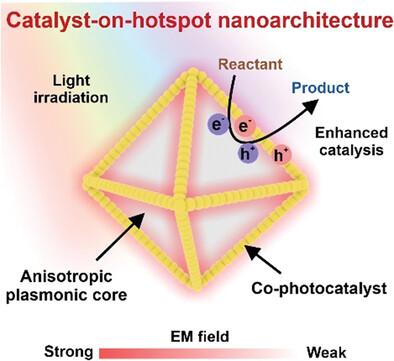Our official English website, www.x-mol.net, welcomes your feedback! (Note: you will need to create a separate account there.)
Catalyst-On-Hotspot Nanoarchitecture: Plasmonic Focusing of Light onto Co-Photocatalyst for Efficient Light-To-Chemical Transformation
Small ( IF 13.0 ) Pub Date : 2024-01-04 , DOI: 10.1002/smll.202309983 Carice Chong 1 , Siew Kheng Boong 1 , Tharishinny Raja Mogan 1 , Jinn‐Kye Lee 1 , Zhi Zhong Ang 1 , Haitao Li 2 , Hiang Kwee Lee 1, 3, 4
Small ( IF 13.0 ) Pub Date : 2024-01-04 , DOI: 10.1002/smll.202309983 Carice Chong 1 , Siew Kheng Boong 1 , Tharishinny Raja Mogan 1 , Jinn‐Kye Lee 1 , Zhi Zhong Ang 1 , Haitao Li 2 , Hiang Kwee Lee 1, 3, 4
Affiliation

|
Plasmon-mediated catalysis utilizing hybrid photocatalytic ensembles promises effective light-to-chemical transformation, but current approaches suffer from weak electromagnetic field enhancements from polycrystalline and isotropic plasmonic nanoparticles as well as poor utilization of precious co-catalyst. Here, efficient plasmon-mediated catalysis is achieved by introducing a unique catalyst-on-hotspot nanoarchitecture obtained through the strategic positioning of co-photocatalyst onto plasmonic hotspots to concentrate light energy directly at the point-of-reaction. Using environmental remediation as a proof-of-concept application, the catalyst-on-hotspot design (edge-AgOcta@Cu2O) enhances photocatalytic advanced oxidation processes to achieve superior organic-pollutant degradation at ≈81% albeit having lesser Cu2O co-photocatalyst than the fully deposited design (full-AgOcta@Cu2O). Mass-normalized rate constants of edge-AgOcta@Cu2O reveal up to 20-fold and 3-fold more efficient utilization of Cu2O and Ag nanoparticles, respectively, compared to full-AgOcta@Cu2O and standalone catalysts. Moreover, this design also exhibits catalytic performance >4-fold better than emerging hybrid photocatalytic platforms. Mechanistic studies unveil that the light-concentrating effect facilitated by the dense electromagnetic hotspots is crucial to promote the generation and utilization of energetic photocarriers for enhanced catalysis. By enabling the plasmonic focusing of light onto co-photocatalyst at the single-particle level, the unprecedented design offers valuable insights in enhancing light-driven chemical reactions and realizing efficient energy/catalyst utilizations for diverse chemical, environmental, and energy applications.
中文翻译:

热点催化剂纳米结构:将光等离激元聚焦到共光催化剂上,实现高效的光向化学转化
利用混合光催化整体的等离子体介导的催化有望实现有效的光到化学转化,但目前的方法受到多晶和各向同性等离子体纳米粒子的弱电磁场增强以及贵重助催化剂利用率不佳的影响。在这里,通过引入独特的热点催化剂纳米结构来实现高效的等离激元介导的催化,该纳米结构是通过将共光催化剂战略性地定位到等离激元热点上以将光能直接集中在反应点而获得的。使用环境修复作为概念验证应用,热点催化剂设计 (edge-AgOcta@Cu 2 O) 增强了光催化高级氧化过程,实现了约 81% 的卓越有机污染物降解尽管与完全沉积设计(全 AgOcta@Cu 2 O)相比,Cu 2 O 共光催化剂较少。 Edge-AgOcta@Cu 2 O 的质量归一化速率常数表明,与全 AgOcta@Cu 2 O 和独立催化剂。此外,该设计还表现出比新兴混合光催化平台高 4 倍的催化性能。机理研究表明,密集电磁热点促进的聚光效应对于促进高能光载流子的产生和利用以增强催化作用至关重要。 通过在单颗粒水平上将光等离激元聚焦到共光催化剂上,这种前所未有的设计为增强光驱动化学反应和实现各种化学、环境和能源应用的高效能源/催化剂利用提供了宝贵的见解。
更新日期:2024-01-04
中文翻译:

热点催化剂纳米结构:将光等离激元聚焦到共光催化剂上,实现高效的光向化学转化
利用混合光催化整体的等离子体介导的催化有望实现有效的光到化学转化,但目前的方法受到多晶和各向同性等离子体纳米粒子的弱电磁场增强以及贵重助催化剂利用率不佳的影响。在这里,通过引入独特的热点催化剂纳米结构来实现高效的等离激元介导的催化,该纳米结构是通过将共光催化剂战略性地定位到等离激元热点上以将光能直接集中在反应点而获得的。使用环境修复作为概念验证应用,热点催化剂设计 (edge-AgOcta@Cu 2 O) 增强了光催化高级氧化过程,实现了约 81% 的卓越有机污染物降解尽管与完全沉积设计(全 AgOcta@Cu 2 O)相比,Cu 2 O 共光催化剂较少。 Edge-AgOcta@Cu 2 O 的质量归一化速率常数表明,与全 AgOcta@Cu 2 O 和独立催化剂。此外,该设计还表现出比新兴混合光催化平台高 4 倍的催化性能。机理研究表明,密集电磁热点促进的聚光效应对于促进高能光载流子的产生和利用以增强催化作用至关重要。 通过在单颗粒水平上将光等离激元聚焦到共光催化剂上,这种前所未有的设计为增强光驱动化学反应和实现各种化学、环境和能源应用的高效能源/催化剂利用提供了宝贵的见解。












































 京公网安备 11010802027423号
京公网安备 11010802027423号